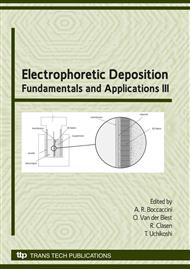p.233
p.237
p.243
p.249
p.255
p.261
p.267
p.273
p.279
Electrophoretically Deposited Porous Ceramics and their Characterisation by X-Ray Computer Tomography
Abstract:
Planar zirconia green bodies with unidirectionally aligned pore channels were prepared by an electrophoretic deposition method using an effect which is usually disadvantageous for the EPD from aqueous suspensions: the formation of gas bubbles by electrolysis. Aqueous ZrO2 suspensions containing acetic acid to enable a sufficient gas generation were used for the EPD experiments. The influence of selected parameters – electrolyte content, applied voltage, and kind of deposition electrode – on the pore structure has been investigated. The green bodies were sintered at 1450 °C in air. Optical microscopy and X-ray computer tomography (CT) were used for characterising the porous structures. CT-investigations have the advantage of a three-dimensional characterisation of the samples by a non-destructive method. The resulting pore structure depended to a high degree on the experimental conditions of the EPD. The kind of the deposition electrode – platinum foil or platinum gauze on foil – had a strong influence on the arrangement of the pores. The EPD on Pt-foil led to randomly arranged pores, whereas very regular pore structures were obtained by the use of Pt-gauze.
Info:
Periodical:
Pages:
255-260
Citation:
Online since:
June 2009
Authors:
Price:
Сopyright:
© 2009 Trans Tech Publications Ltd. All Rights Reserved
Share:
Citation:


